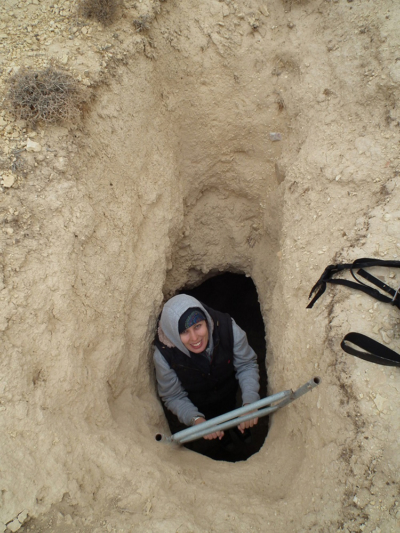
Lucy Wadeson is a Wiener-Anspach postdoctoral fellow at the ULB. She recently came back from Petra, where she excavated with Prof. Laurent Tholbecq (CReA-Patrimoine). In this interview she outlines the subject of her research: the Nabatean funerary culture and its many mysteries.
You are specialized in the archaeology of the Greco-Roman Near East and have been studying the Nabateans for several years. Could you briefly present this ancient people? The Nabataean kingdom (4th century BC – 2nd century AD), at its widest extent, reached north to Damascus and south to Madâ’in Sâlih (ancient Egra) in north-west Arabia, and included the Negev and Sinai deserts to the west and parts of the Jordanian desert to the east. The administrative, religious, political, commercial and cultural centre of this kingdom was Petra, famous for its monuments carved in the rocky landscape. This city was on the crossroads of the major trade and communication routes that traversed the region, linking Arabia to the Mediterranean. As a result, Nabataean culture was a unique blend of Greco-Roman and Arabian influences. Given the limited literary evidence for the Nabataeans and Petra and the paucity of archaeological remains between the 4th and 1st centuries BC, there are gaps in our knowledge about the evolution of Nabataean history and society. The date of settlement and subsequent development of Petra is an unresolved issue. The origins of the Nabataeans also remain uncertain and it is debated whether they originally migrated to southern Jordan from the northern areas of modern Saudi Arabia or whether they descended from the Edomites who had earlier inhabited the area.
Your postdoctoral research is entitled “Tombs with a view: The ‘Royal’ Necropolis of al-Khubthah at Petra”. Why is the word “royal” between quotation marks?
The tombs I’m focusing on in this particular necropolis are called the royal tombs because they have some of the largest and most elaborate façades among the tombs at Petra as well as dominant positions over the city centre. Furthermore, fragmentary inscriptions were discovered in one tomb that mentioned members of the Nabataen royal family. However, most of the tombs have been looted and it is rare to find surviving inscriptions, which means we lack precise data on who was buried in them and when they were carved.
A peculiarity of this area is that funerary space and domestic space appears to be integrated. Is that a unique feature at the time or do you find the same thing in other cultures?
This is another aspect of my research, trying to work out whether this was a result of chronological development (whether tombs were originally outside the domestic areas, but when the city expanded houses began to be constructed in old cemeteries), or whether tombs and houses were more or less contemporary (i.e. the Nabateans didn’t have a problem living very close to tombs and this represents a particular Nabataean concept of space).. In that period, when you look at cemeteries in Roman cities for example, there’s a very strict separation between domestic and funerary space and tombs are located outside the city walls. The neighboring Jews also had very strict rules about burial. Coming back to Petra, the construction of the main theatre destroyed a large part of a necropolis, and you can still see the holes of the chambers next to the top-row seats. These peculiarities need further investigation.
You just came back from Petra, where you excavated with Prof. Laurent Tholbecq a structure he had discovered on the summit of the plateau of Jebel Khubthah. Can you tell us more about these findings?
Well, we actually found out that it wasn’t a tomb! It had the characteristics of a Nabataean built tomb, which are usually found in other Nabataean sites, where the landscape is different. In Petra you have all these magnificent cliffs and rock-faces that were exploited to carve tombs. We started digging there in May – but finally it wasn’t a tomb – there were no burial places, no human remains or typical objects found in tombs. The current interpretation is that it was a kind of cultic platform. In Nabataean religion it would be a môtab, a solid, cubic structure on top of which they would sacrifice and make offerings. On top of this mountain there are a many cultic installations, so it’s clearly associated with the activities that were going on there. But it’s also unique in its typology, that’s why we were mistaken, because it looked more like a tomb from the exterior. It’s still all very new!
What will be the next phase of your research project? I will continue my own excavation of two tombs at the base of Jabal Khubhta, in the ‘royal’ necropolis. I excavated in October last year and in August I will go back to Jordan to work on the finds. What I would also like to do is clear one or two of the monumental built tombs that we have discovered in the hinterland of Petra, possibly in October.


